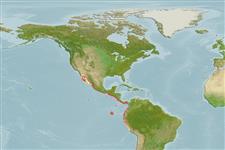Common names from other countries
Environment: milieu / climate zone / depth range / distribution range
экология
морской; солоноватоводный; пределы глубины 0 - 142 m (Ref. 96339). Tropical; 31°N - 14°S, 115°W - 76°W (Ref. 189)
Eastern Pacific: San Juanico Bay, northern Gulf of California southward to Callao, Peru and perhaps further south. The record from Santa Margarita Island on the Pacific coast of Baja California, Mexico is based solely on the now lost type of Stolephorus cultratus.
Length at first maturity / Size / Вес / Возраст
Maturity: Lm 6.0 range ? - ? cm
Max length : 17.0 cm TL самец/пол неопределен; (Ref. 96339); common length : 8.0 cm TL самец/пол неопределен; (Ref. 55763)
Краткое описание
определительные ключи | морфология | морфометрия
колючие лучи спинного плавника (общее число) : 0; колючие лучи анального плавника: 0; членистые (мягкие) лучи анального плавника: 20 - 25. Fairly elongate. Snout long, about 3/4 eye diameter or more; maxilla long, tip pointed, reaching almost to gill opening; gill cover canals of panamensis-type; pseudobranch longer than eye diameter, with 30 or more filaments, extending onto inner face of operculum. Anal fin origin under or just behind base of last dorsal fin ray. Silver stripe along flank about eye diameter.
A schooling species occurring in coastal waters, near shores, entering bays and tolerating some lowering of salinity. Spawns throughout the year, but more intensively in the warmer months. The eggs are oval. The most important tuna baitfish in Manta, Ecuador.
Life cycle and mating behavior
Maturities | размножение | Spawnings | Egg(s) | Fecundities | личинки
Spawns more intensively in the warmer months (Ref. 189). Spawn in school (Ref. 205).
Whitehead, P.J.P., G.J. Nelson and T. Wongratana, 1988. FAO Species Catalogue. Vol. 7. Clupeoid fishes of the world (Suborder Clupeoidei). An annotated and illustrated catalogue of the herrings, sardines, pilchards, sprats, shads, anchovies and wolf-herrings. FAO Fish. Synop. 125(7/2):305-579. Rome: FAO. (Ref. 189)
Статус Красного Списка МСОП (Ref. 130435)
CITES (Ref. 128078)
Not Evaluated
Угроза для людей
Harmless
Использование человеком
рыболовство: не имеет хозяйственного значения; наживка: usually
дополнительная информация
инструменты
Специальные отчеты
Скачать в формате XML
ресурсы в Интернет
Estimates based on models
Preferred temperature (Ref.
115969): 17.2 - 28.9, mean 25 (based on 142 cells).
Phylogenetic diversity index (Ref.
82804): PD
50 = 0.5000 [Uniqueness, from 0.5 = low to 2.0 = high].
Bayesian length-weight: a=0.00513 (0.00232 - 0.01135), b=3.14 (2.96 - 3.32), in cm Total Length, based on LWR estimates for this Genus-body shape (Ref.
93245).
Trophic level (Ref.
69278): 3.4 ±0.4 se; based on size and trophs of closest relatives
устойчивость к внешним воздействиям (Ref.
120179): высокий, минимальное время удвоения популяции до 15 месяцев (Preliminary K or Fecundity.).
Prior r = 0.99, 95% CL = 0.65 - 1.48, Based on 1 data-limited stock assessment.
Fishing Vulnerability (Ref.
59153): Low vulnerability (10 of 100).
